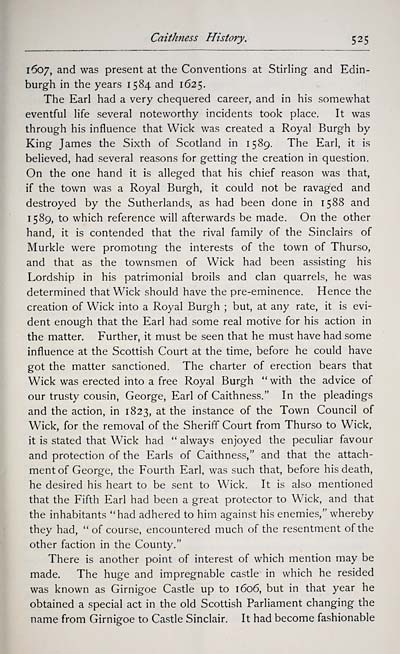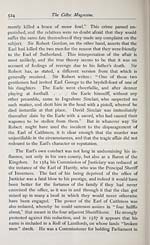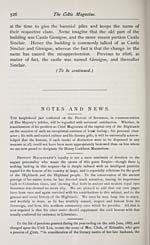Blair Collection > Celtic magazine > Volume 12
(535)
Download files
Complete book:
Individual page:
Thumbnail gallery: Grid view | List view

Caithness History. 525
1607, and was present at the Conventions at Stirling and Edin-
burgh in the years 1584 and 1625.
The Earl had a very chequered career, and in his somewhat
eventful life several noteworthy incidents took place. It was
through his influence that Wick was created a Royal Burgh by
King James the Sixth of Scotland in 1589. The Earl, it is
believed, had several reasons for getting the creation in question.
On the one hand it is alleged that his chief reason was that,
if the town was a Royal Burgh, it could not be ravaged and
destroyed by the Sutherlands, as had been done in 1588 and
1589, to which reference will afterwards be made. On the other
hand, it is contended that the rival family of the Sinclairs of
Murkle were promotmg the interests of the town of Thurso,
and that as the townsmen of Wick had been assisting his
Lordship in his patrimonial broils and clan quarrels, he was
determined that Wick should have the pre-eminence. Hence the
creation of Wick into a Royal Burgh ; but, at any rate, it is evi-
dent enough that the Earl had some real motive for his action in
the matter. Further, it must be seen that he must have had some
influence at the Scottish Court at the time, before he could have
got the matter sanctioned. The charter of erection bears that
Wick was erected into a free Royal Burgh " with the advice of
our trusty cousin, George, Earl of Caithness." In the pleadings
and the action, in 1823, at the instance of the Town Council of
Wick, for the removal of the Sheriff Court from Thurso to Wick,
it is stated that Wick had " always enjoyed the peculiar favour
and protection of the Earls of Caithness," and that the attach-
ment of George, the Fourth Earl, was such that, before his death,
he desired his heart to be sent to Wick. It is also mentioned
that the Fifth Earl had been a great protector to Wick, and that
the inhabitants "had adhered to him against his enemies," whereby
they had, " of course, encountered much of the resentment of the
other faction in the County."
There is another point of interest of which mention may be
made. The huge and impregnable castle in which he resided
was known as Girnigoe Castle up to 1606, but in that year he
obtained a special act in the old Scottish Parliament changing the
name from Girnigoe to Castle Sinclair. It had become fashionable
1607, and was present at the Conventions at Stirling and Edin-
burgh in the years 1584 and 1625.
The Earl had a very chequered career, and in his somewhat
eventful life several noteworthy incidents took place. It was
through his influence that Wick was created a Royal Burgh by
King James the Sixth of Scotland in 1589. The Earl, it is
believed, had several reasons for getting the creation in question.
On the one hand it is alleged that his chief reason was that,
if the town was a Royal Burgh, it could not be ravaged and
destroyed by the Sutherlands, as had been done in 1588 and
1589, to which reference will afterwards be made. On the other
hand, it is contended that the rival family of the Sinclairs of
Murkle were promotmg the interests of the town of Thurso,
and that as the townsmen of Wick had been assisting his
Lordship in his patrimonial broils and clan quarrels, he was
determined that Wick should have the pre-eminence. Hence the
creation of Wick into a Royal Burgh ; but, at any rate, it is evi-
dent enough that the Earl had some real motive for his action in
the matter. Further, it must be seen that he must have had some
influence at the Scottish Court at the time, before he could have
got the matter sanctioned. The charter of erection bears that
Wick was erected into a free Royal Burgh " with the advice of
our trusty cousin, George, Earl of Caithness." In the pleadings
and the action, in 1823, at the instance of the Town Council of
Wick, for the removal of the Sheriff Court from Thurso to Wick,
it is stated that Wick had " always enjoyed the peculiar favour
and protection of the Earls of Caithness," and that the attach-
ment of George, the Fourth Earl, was such that, before his death,
he desired his heart to be sent to Wick. It is also mentioned
that the Fifth Earl had been a great protector to Wick, and that
the inhabitants "had adhered to him against his enemies," whereby
they had, " of course, encountered much of the resentment of the
other faction in the County."
There is another point of interest of which mention may be
made. The huge and impregnable castle in which he resided
was known as Girnigoe Castle up to 1606, but in that year he
obtained a special act in the old Scottish Parliament changing the
name from Girnigoe to Castle Sinclair. It had become fashionable
Set display mode to: Large image | Transcription
Images and transcriptions on this page, including medium image downloads, may be used under the Creative Commons Attribution 4.0 International Licence unless otherwise stated. ![]()
| Early Gaelic Book Collections > Blair Collection > Celtic magazine > Volume 12 > (535) |
|---|
| Permanent URL | https://digital.nls.uk/76466915 |
|---|
| Description | Volume XII, 1887. |
|---|---|
| Shelfmark | Blair.13 |
| Attribution and copyright: |
|
| Description | A selection of books from a collection of more than 500 titles, mostly on religious and literary topics. Also includes some material dealing with other Celtic languages and societies. Collection created towards the end of the 19th century by Lady Evelyn Stewart Murray. |
|---|
| Description | Selected items from five 'Special and Named Printed Collections'. Includes books in Gaelic and other Celtic languages, works about the Gaels, their languages, literature, culture and history. |
|---|

